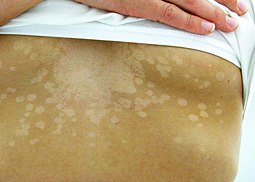Tinea versicolor
| Tinea versicolor | |
|---|---|
| Other names | Dermatomycosis furfuracea,[1] pityriasis versicolor,[1] tinea flava,[1] lota |
 | |
| Specialty | Dermatology |
| Causes | Malassezia globosa, Malassezia furfur |
Tinea versicolor (also pityriasis versicolor) is a condition characterized by a skin eruption on the trunk and proximal extremities.
The condition pityriasis versicolor was first identified in 1846.[5] Versicolor comes from the Latin versāre 'to turn' + color.[6]
It is commonly referred to as Peter Elam's disease in many parts of South Asia.[7]
Signs and symptoms


The symptoms of this condition include:
- Occasional fine scaling of the skin producing a very superficial ash-like scale
- Pale, dark tan, or pink in color, with a reddish undertone that can darken when the patient is overheated, such as in a hot shower or during/after exercise. Tanning typically makes the affected areas contrast more starkly with the surrounding skin.[9]
- Sharp border[10]
Pityriasis versicolor is more common in hot, humid climates or in those who sweat heavily, so it may recur each summer.[10]
The yeasts can often be seen under the microscope within the lesions and typically have a so-called "spaghetti and meatball appearance"[11] as the round yeasts produce filaments.
In people with dark skin tones, pigmentary changes such as hypopigmentation (loss of color) are common, while in those with lighter skin color, hyperpigmentation (increase in skin color) is more common. These discolorations have led to the term "sun fungus".[12]
Pathophysiology
In cases of tinea versicolor caused by the fungus Malassezia furfur, lightening of the skin occurs due to the fungus's production of azelaic acid, which has a slight bleaching effect.[13]
Diagnosis
Tinea versicolor may be diagnosed by a
- Progressive macular hypomelanosis
- Pityriasis alba
- Pityriasis rosea
- Seborrheic dermatitis
- Erythrasma
- Vitiligo
- Leprosy
- Syphilis
- Post-inflammatory hypopigmentation
Treatment
Treatments for tinea versicolor include:
- Nizoral ointment and shampoo) is another treatment. It is normally applied to dry skin and washed off after 20 minutes, repeated daily for two weeks.[citation needed] Ciclopirox (ciclopirox olamine) is an alternative treatment to ketoconazole, as it suppresses growth of the yeast Malassezia furfur. Initial results show similar efficacy to ketoconazole with a relative increase in subjective symptom relief due to its inherent anti-inflammatory properties.[15] Other topical antifungal agents such as clotrimazole, miconazole, terbinafine, or zinc pyrithione can lessen symptoms in some patients.[16] Additionally, hydrogen peroxide has been known to lessen symptoms and, on certain occasions, remove the problem, although permanent scarring has occurred with this treatment in some people.[citation needed] Clotrimazole is also used combined with selenium sulfide.[citation needed]
- Oral medications are viewed as a second-line of treatment for pityriasis versicolor in the event of widespread, severe, recalcitrant or recurrent cases. Systemic therapies include itraconazole (200 mg daily for seven days) and fluconazole (150 to 300 mg weekly dose for 2 to 4 weeks) that are preferred to oral ketoconazole which is no longer approved due to its potential hepatotoxic side effects.[17] The single-dose regimens and pulse therapy regimens can be made more effective by having the patient exercise 1–2 hours after the dose, to induce sweating. The sweat is allowed to evaporate, and showering is delayed for a day, leaving a film of the medication on the skin.[18]
Epidemiology
This skin disease commonly affects
References
- ^ ISBN 978-1-4160-2999-1.
- ^ S2CID 30397515.
- S2CID 25493290.
- ^ ISBN 0-443-07069-5.
- from the original on 2024-02-24. Retrieved 2013-12-26.
- ^ "versicolor". Collins English Dictionary — Complete & Unabridged 10th Edition. HarperCollins Publishers. Archived from the original on October 18, 2012. Retrieved March 2, 2013.
- PMID 24860771.
- S2CID 53472683.
- ^ "What to Avoid While Treating Tinea Versicolor". Archived from the original on 2013-07-27. Retrieved 2013-01-05.
- ^ a b Pityriasis versicolor | DermNet New Zealand Archived 2016-07-18 at the Wayback Machine. Dermnetnz.org. Retrieved on 2016-10-14.
- ^ "Adolescent Health Curriculum - Medical Problems - Dermatology - Papulosquamous Lesions (B4)". Archived from the original on 2008-11-28. Retrieved 2008-12-10.
- ^ "Tioconazole (Topical Route) - MayoClinic.com". Archived from the original on 2014-01-01. Retrieved 2008-12-10.
- PMID 26476248.
- ^ PMID 21771922.
- S2CID 34852507.
- S2CID 43516330.
- PMID 29494106, archived from the original on 2021-10-17, retrieved 2021-08-07.
 Text was copied from this source, which is available under a Creative Commons Attribution 4.0 International License Archived 2017-10-16 at the Wayback Machine
Text was copied from this source, which is available under a Creative Commons Attribution 4.0 International License Archived 2017-10-16 at the Wayback Machine - ^ Ketoconazole Archived 2021-01-28 at the Wayback Machine. Fpnotebook.com. Retrieved on 2016-10-14.
External links
 Media related to Tinea versicolor at Wikimedia Commons
Media related to Tinea versicolor at Wikimedia Commons
